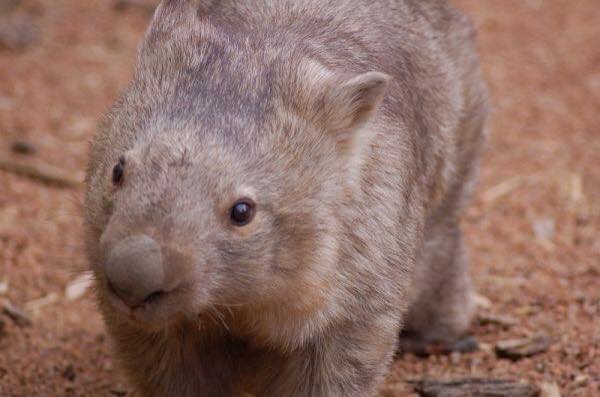Common Wombat (Vombatus ursinus)
Habitat:
The Common Wombat lives in the coastal regions of Australia including: Eastern New South Wales, Eastern and Southern Victoria and the whole of Tasmania. They can be found in woodlands, shrub-lands, heath, coastal regions, hilly and mountainous regions. They seem to prefer wetter, forested, rocky, sloping ground regions that are cooler with burrow drainage.
Description:
Common Wombats are short, stocky, barrel-shaped animals that have a broad head with a large, shiny, bare, black nose, small eyes, small triangular ears, short neck, powerful shoulders and legs with long flat claws and a very small tail hidden by fur. The wombat’s bristle-like fur ranges in colour from sandy hues to darker browns and black.
Status:
Least Concern
Interesting facts:
- Common Wombats are the largest burrowing mammal and the second largest marsupial in the world, averaging 90-115cm in length and are known as the “bulldozers of the bush”.
- The Wombat’s rump is protected by a bony plate and acts as a defensive shield if chased down into its burrow.
- Wombats are mostly nocturnal, usually coming out at night in the warmer months and can be seen grazing or basking in the sun in cooler months.
- Each wombat can have a home range of 5-27ha which would encompass a number of burrows and will overlap the territory of other wombats. Their home range size depends on the location and quality of feeding areas.
- Wombats are territorial animals and mark their home range by grunting at intruders, rubbing their scent on trees and scattering cube like droppings.
- Diet: grass, shrubs, roots, bark, moss, hedges and herbs. To accommodate their fibrous diet, their teeth grow continuously to allow for constant wear.
- Reproduction: Wombats have a gestation period of 20-30 days, usually only one young is born at a time and its development continues in the mothers pouch for the next 6 months, after which it stays with its mother until it is 18 months old. The joey will mature at 2yrs of age.
- Wombat pouches face backward so that dirt doesn’t get inside when burrowing.
- Burrows can be up to 20m long and more than 2m below the ground, and can have numerous connecting tunnels and entrances.
- Lifespan: 5-26 years.

Common Wombat Population Distribution Map






